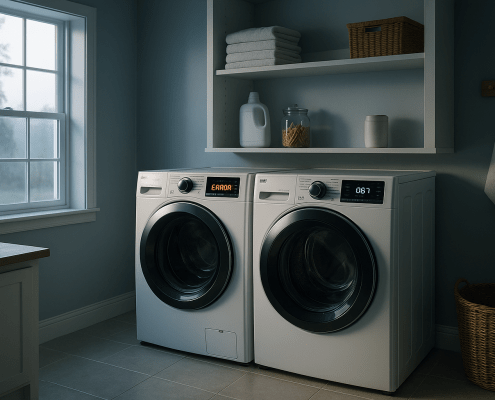What Error Codes E05 and E06 Mean on Your Bosch Washer
Steven E / Tuesday May 13, 2025
Temperature sensors, also called thermistors, play a key role in managing wash cycles and ensuring safe operation. The E05 and E06 Bosch washer error codes on Bosch and Siemens washing machines indicate an issue with the NTC temperature sensor that requires troubleshooting and repair. This article provides an in-depth look at diagnosing and resolving these common error codes.
If you find out that you need any replacement parts for your appliance while you’re troubleshooting, you can enter your model number at AppliancePartsPros.com to order them. Most orders arrive in just two business days, and we have thousands of free guides to show you how to install your new parts.
The information in this article may not apply to your specific appliance model. We recommend consulting your manufacturer’s documentation or contact us with any questions.
What the error codes mean
E05 – NTC open circuit
The E05 error is displayed when the washer control cannot detect the NTC sensor. This is most commonly caused by:
- Damaged or faulty NTC circuit
- Loose wire connections
- Broken wiring harness
An open circuit means the control module is no longer receiving any signal from the NTC sensor.
E06 – NTC short circuit
An E06 error indicates internal damage that is causing a continuous short circuit inside the NTC sensor. This issue requires replacing the faulty NTC.
Function of the NTC sensor
NTC stands for negative temperature coefficient thermistor. This sensor measures water temperature during the wash and rinse cycles.
The control module monitors the NTC input to determine when water has reached the target temperature. It controls the heater and cycle progression based on this sensor data.
On Bosch washing machines, the NTC sensor is mounted into the top of the tub and protrudes into the wash water. Wires connect it to the control module.
Safety precautions
When working on any appliance, remember to keep safety first. Here are some tips to keep in mind:
- Always power off and unplug your appliance or switch off the circuit breaker before attempting any maintenance or replacement work. This keeps you safe by preventing any risk of injury from electric shock.
- Wear insulated work gloves to protect your hands from sharp metal parts, pinching hazards and debris.
- Take your time and don’t rush while working to prevent accidents and personal injuries.
- Work in a well-lit area so you can clearly see and access the interior parts.
- Clear your workspace of clutter and other obstacles. Keep children and pets away from the work area.
- Never work on internal parts with bare wet hands. Make sure the work area is completely dry.
- Check your user manual to see if there are specific installation or safety instructions for your part or appliance.
- Be gentle when handling or removing parts. Excessive force might damage the appliance or cause injury.
- Wear safety glasses when working with chemicals, dust or cleaning large debris to prevent injury.
- If the appliance has recently been used, give it plenty of time for any heating parts to cool down before working on it.
- Take pictures or make a note of wiring terminals or other connections before disconnecting to prevent any problems with reassembly.
- When working with wires, avoid touching any exposed wires or terminals. If you need to touch a wire, use a non-conductive tool or wear insulating gloves to prevent electrical shock.
Troubleshooting steps
Step 1: Check resistance of NTC sensor
- The first troubleshooting step is to check the resistance of the NTC sensor itself using a multimeter. Refer to the manufacturer service documentation for the correct resistance range at room temperature.
- Set the multimeter to the Ohms setting. Disconnect the NTC wires from the control module. Place probe tips across the two sensor terminals. A normal NTC will show some resistance, typically between 5,000-50,000 Ohms at room temperature.
- If you see an extremely high, out-of-range reading, the NTC is damaged internally and must be replaced. An OL (over limit) error means an open circuit.
Step 2: Inspect sensor wiring
Inspecting the sensor wiring is crucial to ensure that the issue is not related to faulty connections or damaged wires. This step involves carefully examining the wiring between the NTC sensor and the control module. Here’s an expanded version of this step:
- Examine the wiring harness for any signs of damage, such as frayed or exposed wires, cuts, or abrasions. Pay close attention to the wire insulation and connectors.
- Ensure that the sensor connector is securely and properly seated in its socket. Gently tug on the wires to check for any loose connections. Make sure the connectors are clean and free from corrosion.
- While measuring resistance using a multimeter, gently jiggle the wires and connectors. Watch the multimeter for any fluctuations in the resistance reading. This could indicate an intermittent open circuit caused by a loose connection.
- If you identify any wires with damage, cut, or corrosion, carefully cut out the damaged section using wire strippers. Strip the ends of the wires and use solder and heat shrink tubing to create a secure and insulated splice. Ensure that the repaired section is neatly organized and well-protected.
- Use wiring that meets the manufacturer’s specifications for wire gauge and temperature rating. Using incorrect wire specifications could lead to further issues.
Step 3: Replace NTC sensor
If the wiring is intact and the short circuit fault is within the NTC sensor itself, it’s necessary to replace the sensor. Here’s an expanded version of this step:
- Obtain an exact replacement NTC sensor with the correct specifications. The internal resistance curve of the sensor is precisely calibrated for optimal washer operation. Using an incorrect replacement could lead to further issues.
- Disconnect the old NTC sensor and carefully install the new one in its place. Ensure that the sensor is securely seated and properly connected to the wiring harness.
Step 4: Retest washer operation
After addressing the wiring and connection issues, it’s essential to verify whether the E05 error has been resolved. Here’s an expanded version of this step:
- Reconnect all wires according to their original positions. Make sure the connections are tight, and terminals are securely seated in their sockets.
- Power cycle the washer to clear any previously recorded error codes. This often involves unplugging the washer from the power source, waiting for a brief period, and then plugging it back in.
- Run a test wash cycle to ensure that the NTC sensor is now functioning correctly and that the E05 error no longer appears. Monitor the washer’s performance during the test cycle to confirm that it reaches the appropriate temperatures without triggering the error.
Additional information
Thank you for reading! We hope you found this information useful to get your working again.
If you have any other appliance repair needs or projects, don’t hesitate to explore our thousands of free videos and troubleshooting guides available. If you need replacement parts or some extra help, grab your model number and head over to AppliancePartsPros.com, where you can chat with a pro, order parts, read our DIY blog, and more.
Be sure to subscribe to us on YouTube and follow us on Facebook, Twitter, and Instagram!
With nearly a decade of experience in providing top-notch customer service regarding appliance parts and repair, Steven enjoys sharing practical advice, troubleshooting tips, and interesting information to help readers stay informed.





